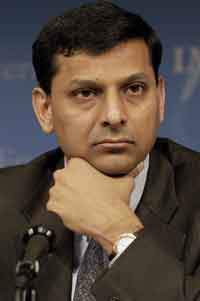Hard Landing Or Harder One? The Fed May Soon Need To Choose
Raghuram Rajan
 In his testimony to Congress earlier this week, Federal Reserve chair Jay Powell indicated “the ultimate level of interest rates is likely to be higher than previously anticipated” and “restoring price stability will probably require that we maintain a restrictive stance for some time”. This was the tough Fed on display, and markets accordingly tanked. Yet a few weeks earlier, Powell had set the financial markets off to the races when he said, “We can now say, for the first time, the disinflationary process has started.” Financial markets, used to years of easy money, celebrate at the slightest indication that the Fed will soften policy, making its task harder. Yet they are not the only market that is not currently co-operating. In his testimony to Congress earlier this week, Federal Reserve chair Jay Powell indicated “the ultimate level of interest rates is likely to be higher than previously anticipated” and “restoring price stability will probably require that we maintain a restrictive stance for some time”. This was the tough Fed on display, and markets accordingly tanked. Yet a few weeks earlier, Powell had set the financial markets off to the races when he said, “We can now say, for the first time, the disinflationary process has started.” Financial markets, used to years of easy money, celebrate at the slightest indication that the Fed will soften policy, making its task harder. Yet they are not the only market that is not currently co-operating.
Labour markets have, if anything, become even tighter, despite the Fed raising interest rates by 450 basis points since last March, and Friday’s strong jobs numbers did not alleviate concerns. While goods production is slowing after the pandemic increased consumption significantly, services, which are more labour-intensive, are now picking up strongly. Workers are hard to find, especially when it comes to hospitality and leisure. One reason is that the labour force is missing 3.5mn workers relative to pre-Covid projections. Older workers understandably quit during the pandemic, and many did not return. Retirements still continue at an accelerated pace. And tragically, as Powell pointed out, Covid-19 also ended the lives of half a million workers in the US, while a slower rate of immigration has led to about a million fewer workers than expected.
In addition, given the difficult nature of jobs in leisure and hospitality, workers have sought opportunities elsewhere in the economy. And perhaps as importantly, companies have been holding on to their staff precisely because hiring has been so hard. Until they are confident that the economy will slow down and they will not need these workers, and also perhaps until they see enough unemployment around them to signal that hiring will not be difficult in the future, labour hoarding may continue.
Other markets are also treading water. For instance, US house sales have slowed considerably, but property prices have generally held up, probably because there is not much supply entering the market. With mortgage rates having risen by so much over the past year, a homeowner with a 30-year mortgage at 4 per cent will have to shell out much more in monthly payments if she upgrades to a slightly better house with a new mortgage at 7 per cent. Because she cannot afford to buy, she does not sell. And because this is limiting the supply of homes on the market, there is only modest downward pressure on prices.
Finally, inflation has been trending down because pandemic-induced supply chain disruptions and war-induced commodity supply disruptions are now being sorted out.
Beliefs in a painless “immaculate disinflation” and soft landing lead to a self-reinforcing equilibrium, in which few believe the Fed will have to do much more. As a result workers are not being laid off, financial asset prices and housing are holding up, and households have the jobs and wealth to keep spending. But without some slack in the labour market, the Fed cannot feel comfortable pausing its efforts.
To get the job done, therefore, the Fed has to force markets to abandon their belief that disinflation will involve only mild job losses. Indeed a recent study by Stephen Cecchetti and others suggests that every disinflation since the 1950s has involved a significant rise in unemployment.
There are dangers in the Fed taking a soft landing with mild job losses off the menu of possible outcomes.
The first, evidenced by the questioning Powell underwent during his Congressional testimony, is that politicians will be irate if the Fed torpedoes a recovery they have just bought with trillions of dollars in fiscal spending. The central bank is not immune from Congressional wrath.
Second, the benign equilibrium may turn into a vicious one. The markets could have their Wile E. Coyote moment. Lay-offs may spur more lay-offs now that businesses are confident they can hire back if necessary. In turn, laid-off employees may be forced to sell their houses, depressing property prices and reducing household wealth. Unemployment and lower wealth may hurt household spending, which will in turn depress corporate profits. That will lead to more lay-offs, falling financial markets and financial sector stress, and yet more muted spending . . . We may end up with a deeper recession than currently anticipated because it is hard to get just a little unemployment.
Of course, the Fed could then revive the economy by cutting rates, but it will need to be wary of doing so until it sees enough slack build up in the labour market. If it turns too fast, markets will celebrate and the job will be left unfinished. But if it waits until there is sufficient slack, lay-offs could develop a momentum of their own.
The temptation then is for the Fed to be more ambiguous, keep a soft landing on the menu and pray for an immaculate disinflation.
If so, the Cecchetti study warns that the eventual unemployment needed to rein in inflation could be much higher.
The Fed’s only realistic options may be a hard landing and a harder landing. It may be time for it to choose.
 Raghuram Rajan is the Katherine Dusak Miller Distinguished Service Professor of Finance at Chicago Booth. He was the 23rd Governor of the Reserve Bank of India between September 2013 and September 2016. Between 2003 and 2006, Dr. Rajan was the Chief Economist and Director of Research at the International Monetary Fund. Raghuram Rajan is the Katherine Dusak Miller Distinguished Service Professor of Finance at Chicago Booth. He was the 23rd Governor of the Reserve Bank of India between September 2013 and September 2016. Between 2003 and 2006, Dr. Rajan was the Chief Economist and Director of Research at the International Monetary Fund.
Dr. Rajan’s research interests are in banking, corporate finance, and economic development. The books he has written include The Third Pillar: How the State and Markets hold the Community Behind 2019 which was a finalist for the Financial Times Business Book of the Year prize and Fault Lines: How Hidden Fractures Still Threaten the World Economy, for which he was awarded the Financial Times prize for Business Book of the Year in 2010.
Dr. Rajan is a member of the Group of Thirty. He was the President of the American Finance Association in 2011 and is a member of the American Academy of Arts and Sciences. In January 2003, the American Finance Association awarded Dr. Rajan the inaugural Fischer Black Prize for the best finance researcher under the age of 40. The other awards he has received include the Infosys prize for the Economic Sciences in 2012, the Deutsche Bank Prize for Financial Economics in 2013, Euromoney Central Banker Governor of the Year 2014, and Banker Magazine (FT Group) Central Bank Governor of the Year 2016.
www.zerohedge.com
| 

